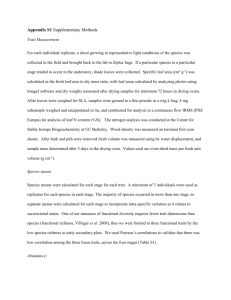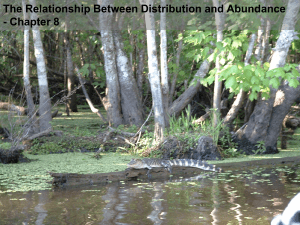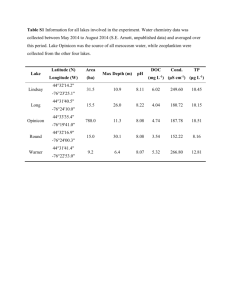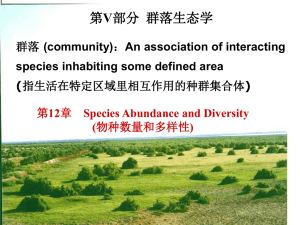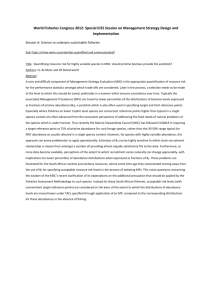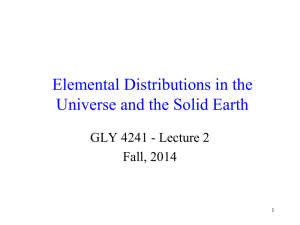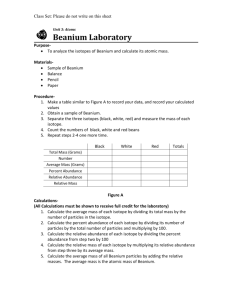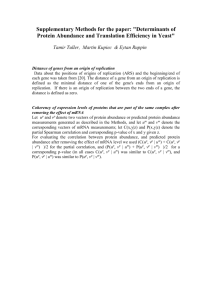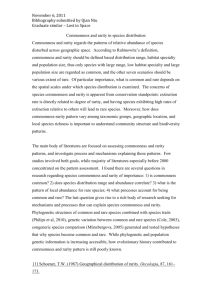ece3915-sup-0007-TableS1-FigS1-S6
advertisement
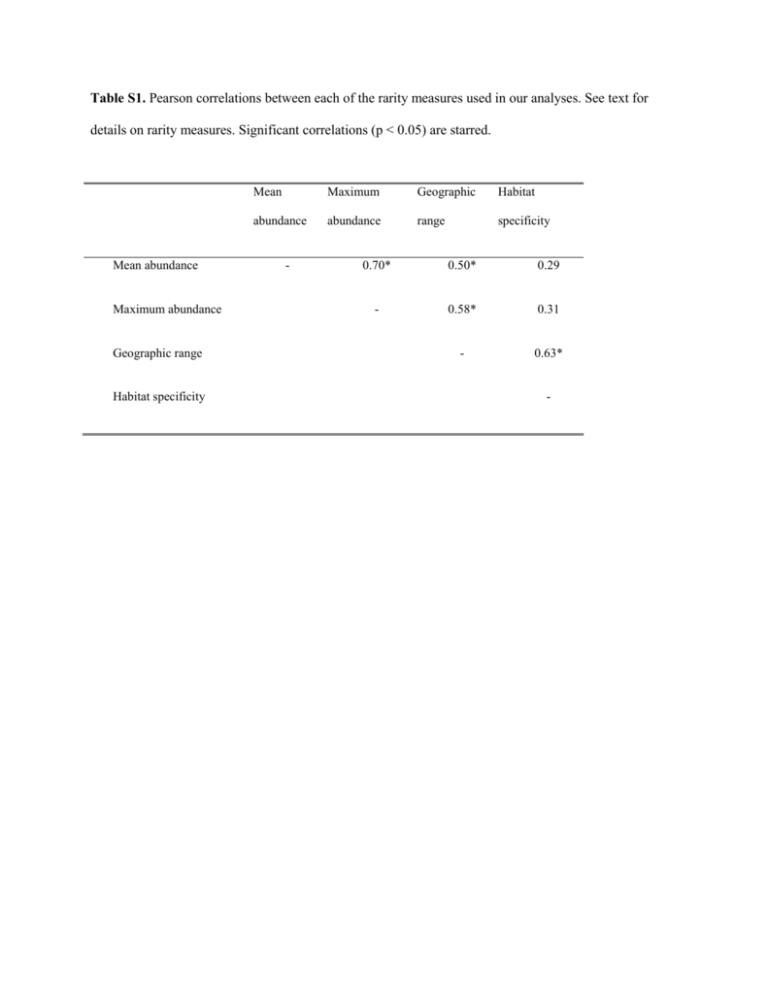
Table S1. Pearson correlations between each of the rarity measures used in our analyses. See text for details on rarity measures. Significant correlations (p < 0.05) are starred. Mean abundance Maximum abundance Geographic range Habitat specificity Mean Maximum Geographic Habitat abundance abundance range specificity - 0.70* 0.50* 0.29 - 0.58* 0.31 - 0.63* - Table S2. Sensitivity analysis examining all three-trait combinations from the four traits used in our analyses. The slope of the regression as well as its p value from the bootstrapped analysis are reported (significance at = 0.05 marked with **, at = 0.1 marked with *). Rare species significantly contribute less to FTV than more common species when rarity is defined by mean abundance (p < 0.10). There is some evidence that plant mass influenced our results since rare species contributed less to FTV when rarity was defined by maximum abundance and geographic range (p < 0.10), however, there was still higher significance when rarity was defined by mean abundance (p < .05). Trait removed from analysis Rarity metric Leaf mass Mean abundance -0.0024 0.025** Maximum abundance -0.0004 0.344 Geographic range -0.0005 0.343 Habitat specificity -0.0005 0.341 Mean abundance -0.0007 0.061* Maximum abundance -0.0006 0.100 Geographic range 0.0002 0.341 Habitat specificity -0.0002 0.346 Mean abundance -0.0006 0.008** Maximum abundance -0.0004 0.080* Geographic range -0.0004 0.061* Habitat specificity -0.0001 0.342 Mean abundance -0.0015 0.049** Maximum abundance -0.0010 0.140 Geographic range -0.0005 0.331 Habitat specificity -0.0014 0.102 Root to shoot ratio Plant mass Leaf nitrogen content Slope of regression Bootstrap p value Table S3. Species names for all 46 species that were considered in our analyses. Rarity rank of each of the four measures of rarity for each of our species is listed, where 1 equals the most common, 46 equals the most rare, and NA identifies species-rarity rank combinations where data were unavailable. Habitat Specificity Rank 19 Geographic Abundance Rank 3 Mean Abundance Rank 13 Max Abundance Rank 30 Agrostis scabra NA 10 14 13 Ambrosia artemisiifolia 15 9 8 12 Ambrosia psilostachya 15 23 23 29 Andropogon gerardii 29 25 4 7 Anemone cylindrica 35 37 31 16 Aristida basiramea 19 40 30 41 Artemisa campestris 15 22 36 34 Artemisia ludoviciana 15 20 27 24 Berteroa incana 15 28 9 14 Boechera grahamii 39 37 37 45 Bromus inermis 15 7 24 19 Carex sp. 25 NA 5 6 Crepis tectorum NA 3 10 20 Digitaria cognata 25 37 39 37 Dichanthelium oligosanthes 31 21 16 32 Dichanthelium perlongum 39 28 32 25 Dichanthelium acuminatum var. acuminatum 39 31 33 27 Elytrigia repens 15 11 3 8 Erigeron canadensis NA 32 12 15 Erigeron strigosus 19 17 38 44 Fragaria virginiana 19 5 25 9 Hedeoma hispidum 33 29 22 43 Helianthus sp. NA NA 46 42 Hesperostipa spartea 41 42 28 19 Koeleria macrantha 41 28 43 38 Lathyrus venosus 35 34 26 33 Lespedeza capitata 29 33 20 28 Lithospermum caroliniense 39 38 42 35 Species Name Achillea millefolium Monarda fistulosa 22 20 35 31 Physalis virginiana 33 31 34 36 Poa pratensis 15 1 1 2 Polygonum convolvulus 15 5 19 10 Potentilla recta 15 16 44 23 Rosa arkansana 25 40 21 26 Rubus sp. NA NA 18 4 Rumex acetosella 15 6 7 21 Schizachyrium scoparium 29 16 2 1 Silene latifolia 22 20 17 39 Solidago gigantea 22 12 11 5 Sorghastrum nutans 29 25 15 18 Stachys palustris 31 41 40 40 Tragopogon dubius 15 43 45 46 Tradescantia occidentalis 15 14 29 17 Verbascum thapsus 15 9 41 22 Vicia villosa 15 14 6 3 Figure S1. Unscaled rank-abundance plots of the 248 plant species present in the Cedar Creek oldfield survey, showing mean abundance for each species; error bars are ± 1 s.e. Species for which we have trait data, and are thus included in our analyses, are highlighted in red. Species are ranked from the most common to the most rare. Our analyses included 28 species that had mean abundances less than 10% of the 10 most common species, and 18 species that had mean abundances less than 5% of the 10 most common species suggesting that we covered a wide range of rarity ranks in our study. - Species in oldfield survey Species with trait data +/- 1 s.e. of mean percent cover 6 4 - 2 ---------------------------------------------------------------------------------------------------------------------- 0 Percent cover 8 10 - 0 50 100 150 Rank 200 250 Figure S2. Pearson correlation coefficients (r) between the four traits considered in our study: leaf nitrogen, leaf mass per area (LMA), root to shoot ratio, and plant mass. Histograms of each trait are on the diagonal, scatterplots of the two-way pairings of traits are in the upper-right, and correlation values are in the bottom-left. Significant correlations are in bold. Figure S3. Summary of principal component analysis of the four selected traits across the 46 species. The first principal component (PC1) represents part of the leaf economics spectrum, with leaf mass per area (LMA) and leaf nitrogen concentration (pctN.leaves) negatively correlated with each other; this axis represented 47.7% of the variance (bottom right panel). Plant size (plantmass) was partially correlated with LMA for these grassland plants. PC2 separates plants along a root investment gradient, with graminoids at the high end; this axis represents and additional 26.9% of the variance. PC3 is driven mostly by plant size and captures 18.1% of the variance, for a total of 90.5% of the variation in these three orthogonal axes. Figure S4. Principal component-based convex hull volumes, showing the influence of individual species on the change in hull volume. As for the non-reduced trait value convex hull volumes shown in Fig. 3, relationships between community trait space change and rarity are neutral or only weakly negative, reinforcing the result that rare species have important contributions to potential functional diversity. Figure S5. Contribution of each species to abundance-weighted community FTV based on the four measures of rarity used in this study. Community FTV is the functional trait volume of the 46 species considered in our study. Each point represents the mean absolute contribution of each species to the total community FTV. Species are ranked from the most common to the most rare along the x-axis. A regression line is plotted for each graph, and when significant, is highlighted in red. Regressions are significant when rarity is defined by mean abundance, maximum abundance, and habitat specificity (p < Addition to Community FTV Addition to Community FTV 0.05). 0 10 20 30 40 0 20 30 40 Addition to Community FTV Maximum Abundance Rank Addition to Community FTV Mean Abundance Rank 10 0 10 20 30 Geographic Range Rank 40 0 10 20 30 Habitat Specificity Rank 40 Figure S6. Comparison of the contribution of each of the 46 species to FTV compared to the contribution of the same species to 1,111 constructed null communities. Community FTV is the functional trait volume of the 46 species considered in our study. A significant p value indicates that the species is contributing more to its present community than is expected by chance and that our FTV analyses may be influenced by the particular composition of the communities in which the species is found. The results of this analysis suggest that no species is being influenced by the composition of the specific communities in which it is found given that all p ≥ 0.05.
